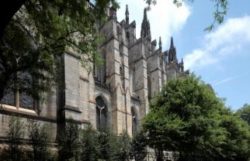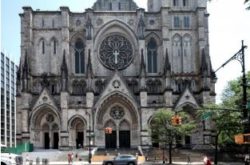
Image Credit: LPC.
Landmark site would include six associated buildings, as well as massive Episcopal cathedral. Landmarks held a hearing on the potential designation of St. John the Divine and the Cathedral Close at its meeting on December 6, 2016. Landmarks previously designated the Cathedral an individual City landmark in 2003, but the designation was overturned by the City Council. Council Members wished to see a designation that included surrounding properties, rather than just the footprint of the Cathedral. Diocesan officials opposed any wider designation, claiming they needed to develop some of the property to capitalize the Cathedral’s completion.
When Landmarks again added the Cathedral as well as six surrounding historic buildings to its calendar in July of 2015, Chair Meenakshi Srinivasan stated that the “moment is now” for the City to take action on designating the site. Development on the Cathedral complex remains an ongoing and contentious issue.
The Cathedral, the Seat of the Episcopal Diocese of New York, is the largest church in the United States and the largest cathedral in the world, with a length of 601 feet and height of 124 feet. Landmarks Research Department called the Cathedral “one of the most impressive architectural statements in the City.”
Architectural firm Heins and LaFarge were the winners of design competition for the Cathedral, and work began in 1892. The winning proposal incorporated elements of Romanesque, Byzantine, and Gothic styles. A second phase of construction began in 1916, overseen by architect Ralph Adams Cram, who sought to complete the Cathedral in a French Gothic design. By 1941, the nave and west front were completed, and the north transept begun. A third phase of construction commenced in 1979. Work on the unfinished Cathedral is still ongoing.
The oldest building in the proposed landmark campus dates to the first half of the 19th century, and is the sole remnant of the Leake and Watts Orphan asylum, which occupied much of the land now developed as Morningside Heights. The other buildings in the proposed landmark site include the Cram-designed Synod House, the Deanery and the Bishop’s House. The Collegiate Gothic-style St. Faith’s House and Choir School would complete the ensemble.
Church Dean James Kowalski said the church had worked with Landmarks staff to understand the ramification of landmarking, and now endorsed designation as the next step in celebrating and providing stewardship of the complex’s “great architectural legacy.” Kowalski noted that the church was approaching the 125th anniversary of the laying of the Cathedral’s cornerstone, and its construction had been episodic. He hoped designation would not inhibit the Cathedral’s further evolution over the coming decades and centuries.
Architect Susan Rodriguez, who had long counted the church among her clients, testified designation would formalize the Cathedral’s landmark status, and its importance as a sacred and a civic space. She noted that maintaining and modernizing the Cathedral involved immense cost and complexity. Consultant Elise Quasebarth said the completion of the complex was an “ongoing monumental undertaking,” and that the development of the close was part of the original designers’ as wells as the church’s trustees’ plan.
Council Member Mark Levine endorsed the designation of the Cathedral complex, as part of his testimony supporting the creation of a Morningside Heights Historic District. The Historic District Council’s Kelly Carroll decried the construction of two condominium buildings on the campus before the church’s completion, and said the organization hoped landmark designation would protect the complex from further “aesthetic erosion.” Laura Friedman, of the Morningside Heights Historic District Committee, said the stewards of the Cathedral campus had obviated their responsibilities, and the two residential towers built on church property were the “Penn Station of Morningside Heights.” She urged Landmarks to protect the complex from any further inappropriate development.
Commissioner John Gustaffsson expressed appreciation for the church leadership’s attitude towards designation, and said he hoped that Landmarks would be equally understanding of the church’s “ongoing needs and challenges.” Chair Srinivasan thanked the church leadership for their cooperation, and said there was no doubt that the complex was “incredibly important to the City.” Srinivasan closed the hearing without establishing a date for a vote on designation, but said it would likely take place in early 2017.
LPC: Cathedral Church of St. John the Divine and Cathedral Close, 1047 Amsterdam Ave., Manhattan (LP-2585) (Dec. 6, 2016).


